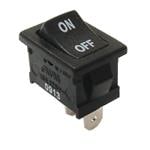What is an SCR in power electronics?
A Silicon Controlled Rectifier (SCR) is a type of thyristor — a four-layer, three-terminal semiconductor device used extensively in power electronics for controlling high voltage and current.
It acts as a switch that can turn on and conduct electricity under the right conditions, making it particularly useful in applications requiring precise power control, such as motor drives, light dimmers, and controlled rectifiers.
Structure and operation
An SCR consists of four layers of alternating P-type and N-type semiconductor materials, forming a PNPN structure. It has three terminals:
- Anode (A)
- Cathode (K)
- Gate (G)
The device remains in a non-conducting state until a small current is applied to the gate. Once triggered, the SCR conducts current from the anode to the cathode and continues to do so even if the gate signal is removed, provided the anode current remains above a certain threshold called the holding current.
To stop conduction, the anode current must drop below this holding current — either naturally (e.g. in AC applications, when the voltage goes through zero) or through external circuit arrangements in DC systems.
Key characteristics
- Latching behaviour: Once turned on, the SCR remains on without further gate input
- Unidirectional current flow: It conducts in one direction only, from anode to cathode
- High voltage and current ratings: SCRs can handle thousands of volts and amperes
- Gate sensitivity: Only a small current is needed at the gate to trigger the device
Applications of SCRs
SCRs are ideal for switching and controlling large amounts of power. Common uses include:
- AC power control: In devices like light dimmers, heating controls, and AC motor speed controllers.
- Rectifiers: Controlled rectifiers that convert AC to DC with adjustable output.
- Overvoltage protection: As crowbar circuits to protect sensitive electronics by shorting excessive voltages.
- Inverters and converters: In DC-AC or DC-DC systems where high power levels are involved.
- Battery chargers: For controlling the rate and timing of charging.
Triggering and commutation
- Triggering: The SCR is turned on by applying a gate current during the forward-biased condition (anode positive relative to cathode).
- Commutation: Turning off the SCR (especially in DC applications) requires external circuitry — such as forced commutation using inductors or capacitors — to interrupt current flow.
Advantages and limitations
Advantages:
- Can handle high power levels
- Simple gate control
- Reliable, with no moving parts
Limitations:
- Only turns off when current stops
- Unidirectional conduction limits use in some AC applications
- Slower switching speeds compared to modern transistors
SCRs vs other power devices
Compared with other semiconductor switches such as MOSFETs or IGBTs, SCRs are less suitable for high-frequency switching, but they remain highly relevant in applications where low cost and robustness are priorities, especially in AC systems.
SCRs have been foundational to the development of power electronics and continue to play a vital role in systems where simple, high-power switching is required. While newer technologies have emerged for faster and more efficient switching, SCRs remain relevant due to their durability, low cost, and high voltage handling capability.







